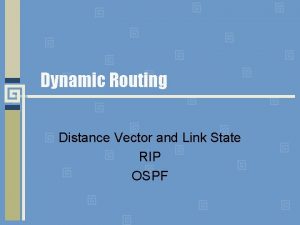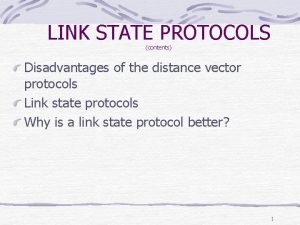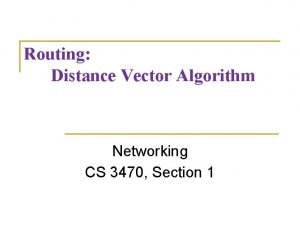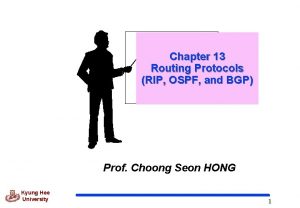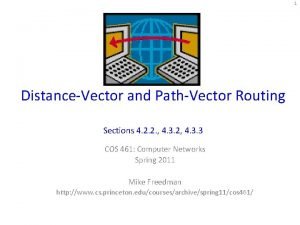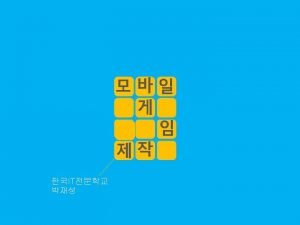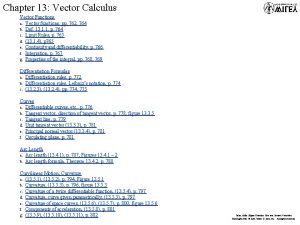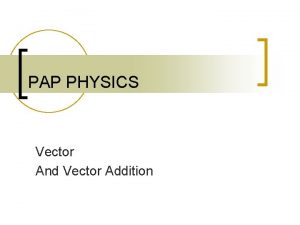Distance Vector link cost changes Link cost changes











- Slides: 11

Distance Vector: link cost changes Link cost changes: 60 x r good news: travels fast 4 r bad news: travels slow - “count to infinity” problem! y 50 1 z At time t 0, y detects the link-cost change, updates its DV, and informs its neighbors. Dy(x) = min{c(y, x)+Dx(x), c(y, z)+Dz(x)} = min{60+0, 1+5} = 6 “Routing Loop” occurs (from y to x: y send to z and z send to y) At time t 1, z receives the update from y and updates its table. Dz(x) = min{c(z, x)+Dx(x), c(z, y)+Dy(x)} = min{50+0, 1+6} = 7 It computes a new least cost to x and sends its neighbors its DV. At time t 2, y receives z’s update and updates its DV, and inform its neighbor Dy(x) = min{c(y, x)+Dx(x), c(y, z)+Dz(x)} = min{60+0, 1+7} = 8 … … r 44 iterations before algorithm stabilizes Network Layer 4 -1

Distance Vector: link cost changes r Increase from cost to Y X Z {4, x } {1, z } Y 4 X 1 50 Z Z X Y {5, y } {1, y } Network Layer 4 -2

Distance Vector: link cost changes Dy(x) = min{c(y, x)+Dx(x), c(y, z)+Dz(x)} = min{60+0, 1+5} = 6 r Increase Y X Z {6, z } {1, z } Y 60 4 X 1 50 Dy(x)=6 Z Z X Y {5, y } {1, y } Network Layer 4 -3

Distance Vector: link cost changes r Increase Y X Z {6, z } {1, z } Y 60 4 1 Dz(x)=7 Routing loop X 50 Z Z X Y {7, y } {1, y } Dz(x) = min{c(z, x)+Dx(x), c(z, y)+Dy(x)} = min{50+0, 1+6} = 7 Network Layer 4 -4

Distance Vector: link cost changes Dy(x) = min{c(y, x)+Dx(x), c(y, z)+Dz(x)} = min{60+0, 1+7} = 8 r Increase Y X Z {8, z } {1, z } Y 60 4 1 Dy(x)=8 Routing loop X 50 Z Z X Y {7, y } {1, y } Network Layer 4 -5

Distance Vector: link cost changes r Increase Y X Z {8, z } {1, z } Dz(x)=9 Y 60 4 1 Routing loop X 50 Too many iterations! (count-to-infinity problem) Z Z X Y {9, y } {1, y } Dz(x) = min{c(z, x)+Dx(x), c(z, y)+Dy(x)} = min{50+0, 1+8} = 9 Network Layer 4 -6

Distance Vector: link cost changes A Solution of “count to infinity” problem : Poisoned reverse: 60 x r If z routes through y to get to x : m 4 y 1 50 z z tells y its (z’s) distance to X is infinite (so Y won’t route to X via Z) r will this completely solve count to infinity problem? Network Layer 4 -7

Distance Vector: link cost changes r Poisoned Reverse Y 3) Dy(x) = min{c(y, x)+Dx(x), c(y, z)+Dz(x)} = min{60+0, 1+ ∞} = 60 X Z {60, x} {1, z} Y 60 4 X 1 50 2) Send Dz(x)=∞ Z Z X Y {9, y } {1, y } Too many iterations! : 1) Detect count-toinfinity problem

Distance Vector: link cost changes r Poisoned Reverse Y X Z {60, x } {1, z } Y 60 4 X 1 50 4) Send Cy(x)=60 Z Z X Y {50, x } {1, y } 5) Dz(x) = min{c(z, x)+Dx(x), c(z, y)+Dy(x)} = min{50+0, 1+60} = 50 Network Layer 4 -9

Distance Vector: link cost changes r Poisoned Reverse Y 7) Dy(x) = min{c(y, x)+Dx(x), c(y, z)+Dz(x)} = min{60+0, 1+ 50} = 51 X Z {51, z } {1, z } Y 60 4 X 1 50 6) Send Cz(x)=50 Z Z X Y {50, x } {1, y } Network Layer 4 -10

Distance Vector: link cost changes r Poisoned Reverse Y X Z {51, z } {1, z } Y 60 4 X 1 50 8) Send Cy(x)=51 Z X Z {50, x } Y {1, y } No Change! 5) Dz(x) = min{c(z, x)+Dx(x), c(z, y)+Dy(x)} = min{50+0, 1+51} = 50 Count-to-Infinite comes to end
 Distance vector vs link state
Distance vector vs link state Advantages of link state routing vs distance vector
Advantages of link state routing vs distance vector How to find the unit vector
How to find the unit vector Vector unitario
Vector unitario Why is vector resolution the opposite of vector addition
Why is vector resolution the opposite of vector addition The position vector r=5.00ti
The position vector r=5.00ti Elizabeth mulroney
Elizabeth mulroney Physical reaction
Physical reaction Vector algorithm
Vector algorithm Distance-vector routing
Distance-vector routing Distance vector routing
Distance vector routing Pathvector
Pathvector
